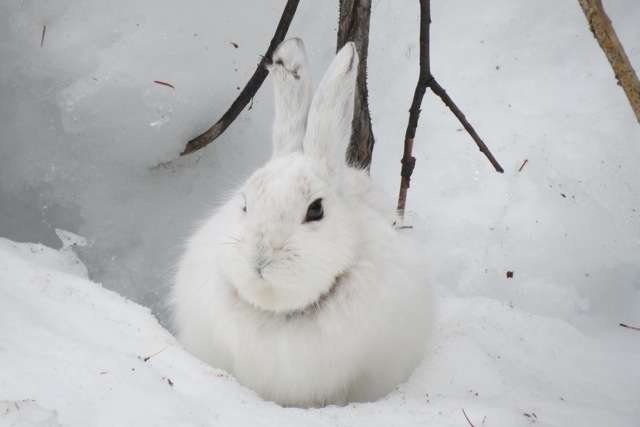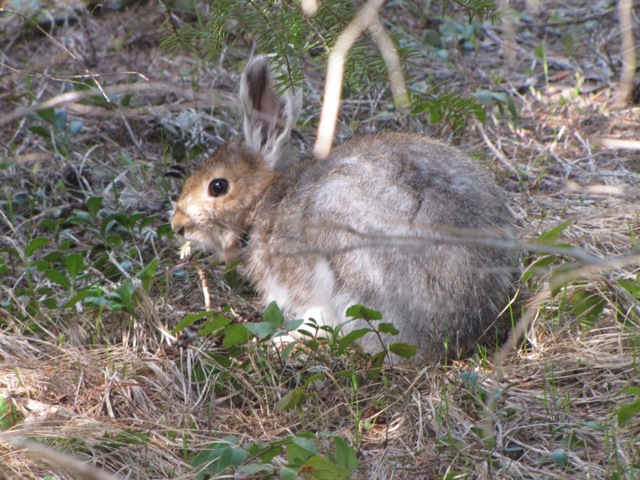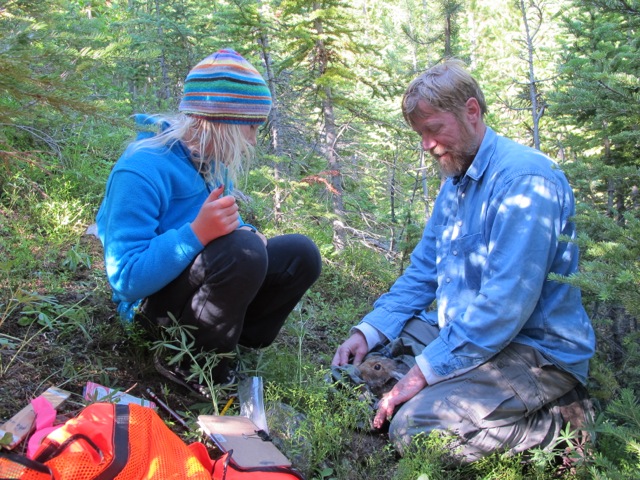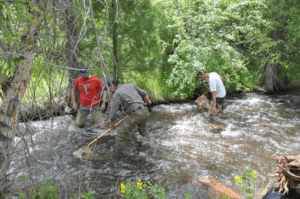


Behind the wheel of his boxy red Ford F-250 truck, L. Scott Mills sipped his watery coffee and headed east. It was 18 degrees out on a dim and wintry Missoula morning. As the sun rose and the sky turned white, Mills followed Montana Route 200 along the lazy Blackfoot River, northeast toward the town of Seeley Lake. Bright yellow larches blazed among the pines, and a dusting of snow from a few days earlier still clung to the hillsides.
Just past Seeley Lake, Mills, who is a conservation biologist at the University of Montana, turned onto an old logging road into the forest and parked behind his field assistants’ blue pickup. Tucker Seitz and Sean Sultaire, two recent UM graduates, were readying antennas and receivers, beginning their daily task of tracking some of the 30-odd radio collared hares hopping around the Seeley-Swan valley this winter. We zipped our jackets, donned blaze-orange vests—hunting season had just begun—and tromped into the woods.
We ducked around lodge pole pines and Douglas firs, traipsing across bear grass and fallen spruce logs on terrain speckled with a light cover of snow. Seitz and Sultaire held their antennas in front of them, turning the metal rods to catch the signal. They listened to the steady beeps on receivers they’d hung from their necks. After about 15 minutes, they closed in on the hare, narrowing its location to an area of about 50 square feet. Then they spotted it.
Under a downed lodge pole, its upper branches and needles intact and forming a curtain of green and brown, the snowshoe hare sat nearly motionless, its lanky ears towering upright above its head. It sat in a small hollow—a “form” in hare-tracker parlance—that it had made in the dirt. It took me a few moments to make out the hare, even with Mills’ help. All that gave it away, finally, was the black of its eye framed by light fur.
Mills’ team is trying to understand a biological phenomenon that’s crucial to animal survival: seasonal camouflage. What drives the periodic coat color change of animals like snowshoe hares, and is it something the animals can adjust? These questions, mused upon for centuries yet never fully studied, lately have taken on extra significance.
Like dozens of species that live in temperate climates around the globe, snowshoe hares grow new coats twice a year to blend with the landscape. As climate change alters these landscapes—and places that once were snowy white become increasingly brown—the animals’ futures will likely depend in part on whether their camouflage can adapt in response.
Evolution is not just about one species ever-so-slowly transforming into another. It’s also about much smaller, much faster changes that can determine whether a species will endure or perish as its world shifts. Aided in part by fast, relatively inexpensive DNA analysis, scientists are tracking these changes, and using them to help predict the future of species. They’re probing fish that live in polluted waters for clues to how they tolerate toxins and sequencing the genes of invasive plants to learn—based on their family trees—which pose the biggest threats to native species.
To make effective conservation decisions in the age of climate change — what to save, how to save it – we need to understand how species adapt and change, and how past and future evolution affects their odds of survival.
* * *
Every week, Mills’ team locates each collared hare and records the color of its coat—what percentage white or brown—and the amount of snow-covered ground in its immediate surroundings. Seitz squatted about four feet away from the male hare and snapped a photo, then moved in closer and clicked again. As Seitz edged forward, the hare hopped from its hideout and covered a few dozen yards of forest before pausing. Out in the open, we could see its fur clearly. It was mostly brown, though flecked with white, and it was predominantly white from its nose up to its eyes.
As winter looms, all the hares in this Montana forest begin to turn white within a week of one another, regardless of snow conditions or temperature, triggered by the disappearing sun. But once it starts, each hare’s transformation—which can take up to two months to complete—is unique. Some hares turn white on their faces first, with their new fur spreading from nose to rump; others metamorphose in reverse. Some hares turn mostly white early on, keeping just a bit of brown for several weeks; others try on a tiny sample of white coat, waiting a while before committing to the whole outfit.
Beyond the initial sunlight trigger, though, what controls this seasonal cycle remains a puzzle. Can this particular hare adjust its internal cycles? Will its descendants acquire a gene that helps match their fur to their habitat?
Because hiding, even in plain sight, is the snowshoe hare’s ticket to survival, you might never see one while walking in the woods. Yet the species is currently doing fine in Montana and elsewhere across North America. That’s good news for these ecosystems’ meat eaters—coyotes, wolves, bobcats, martens, hawks—all of which have a taste for hare. Thanks to the carnivores, a hare’s average life span in the wild is just a year. Nearly all of them meet the same end; it’s only a matter of time.
While this state of affairs is unfortunate from the hare’s perspective, it helps keep the rest of the ecosystem humming along just fine — especially because hares breed like, well, rabbits. But like so much in nature, it’s a fragile balance. If hares become too easy to catch, their populations would likely crash, and could well take down the predators that depend on them.
* * *
Mills, 50, who is trim with sandy blond hair and whose own beard is turning white from the middle outward, began studying snowshoe hares in 1997. Just four years out of his Ph.D. program at U.C. Santa Cruz—he studied the effects of forest fragmentation on voles, working with the prominent conservation biologist Michael Soule—and two years into an assistant professorship at the University of Montana, he began studying hares. He chose them because they are a major food source of the Canada lynx, which was slated for listing under the Endangered Species Act. “Of course, I believe hares are more important than just as grocery items for lynx,” Mills said, sitting in his creaky Missoula office in the university’s 1920s-era Forestry building. “But that’s how I got drawn in.”
The project involved a relatively simple management question: Would certain types of logging disrupt the hare population, and ultimately threaten lynx survival? To answer it, Mills spent several years engaged in the slightly gruesome business of fitting hares with radio collars and essentially waiting for them to die. (He’d record where and when they died, and, if possible, what ate them.)
In the woods tracking hares, Mills began to notice certain patterns. During full moons when there was snow on the ground, the hares tended to move around much less than at other times—and were less likely to live to see the dawn. “When they’re glowing under a full moon on snow,” said Mills, “they respond behaviorally. And there is a cost to making the wrong decision: They die.” He found a similar pattern in open patches of forest, such as areas that had been clear-cut: Hares of either color moved more freely, and survived for longer, in closed-canopy parts of the forest than in the open. In other words, the hares’ visibility makes a big difference to their survival.
Mills also noticed a third pattern, one that seemed counterintuitive at the time. Far more hares died in the fall and spring than in winter or summer. “That was surprising to me when I first saw it,” he recalled, “because you’d think, in winter it’s 20 below zero, the predators are hungry, the snow is deep—shouldn’t hares die more in the wintertime?” But this was ten years ago, before anyone was thinking about mismatches between animals’ camouflage and their habitats.
Because snow doesn’t fall the same amount on the same date from year to year, and because it can take so long for hares to acquire their seasonal coat, inevitably there are times when the animals aren’t camouflaged. They’re mismatched, brown in a white world or white on a snowless backdrop. This was always true—even before humans intervened, in the form of global warming.
Recently, though, anecdotal reports of mismatched hares have been on the rise. Over the past decade, as word of his research has spread, Mills himself has received a growing number of autumn phone calls from hunters. Many of the veteran hunters tell him the same thing—snow is arriving later.
If hares begin to turn white at the same time each year but the snow keeps arriving later, and if the hares are more likely to be eaten when they don’t match their surroundings, then their future could be bleak. Snowshoe hares, with their long legs, slender ears, and outsized feet, could become one more victim of climate change. In this scenario, as winter shrinks, the poor snowshoe hare will fall increasingly out of sync with the new seasonal cycles; eventually, like the polar bear, it’ll become another cover model for collapsing ecosystems.
There’s just one problem with this simple version of things: We have no scientific evidence that it’s true.
Given that species that change their coat color—weasels, ptarmigans, Arctic foxes, hamsters—live across much of the world, our understanding of them is exceptionally sketchy. We don’t know whether hares that are mismatched to their environment are more likely to die. It’s entirely possible that more hares die in spring and fall for some other reason—like changes in forest cover or shifting diets. We don’t even know, in fact, whether there really are more mismatched hares now than there used to be.
It’s even unclear whether the hares know if they’re camouflaged. Coming upon one that’s white when the ground is bare, or brown when the forest is snow-covered, is “like the most embarrassing thing that can happen in the field,” said Mills. “It’s like walking in on someone taking a shower. Because you look over and there six feet away from you is this totally white hare that’s just sitting there. And it feels like that hare is thinking, ‘Oh, yeah, he can’t see me.’ But then other times” — when the hares bolt—“it seems like they really can look down and say, ‘Yikes, I’m mismatched!’ So we’re trying to quantify it.”
One thing is certain, though: On average, there are fewer days of snowpack than there used to be. In fact, it was at a lecture on global warming’s regional impacts in 2007 that Mills had an eureka moment about the future of his research. Steve Running, a Missoula colleague and Nobel Peace Prize recipient for his work with the Intergovernmental Panel on Climate Change, was giving a public talk. He put up a slide showing that the biggest sign of climate change across the world’s temperate regions wasn’t a change in temperature, but a decline in the number of days with snow-covered ground. “When I saw that slide of his,” said Mills, “it all came together for me to realize, wow, okay, so these hares are changing no matter what, and they’re confronting this reduction of snow on the ground. That’s when it all crystallized.”
Mills’ excitement about an important new line of inquiry was quickly tempered by heartache. Suddenly, his previous hare research represented a dozen years of missed opportunities. He hadn’t collected a single piece of information on coat color. More than four years after Running’s talk, he’s still kicking himself. “I had all these radio-collared hares in the late ‘90s,” he lamented, “but it just didn’t occur to me to record their coat color when they were killed.”
* * *
A few years ago, Mills attended a meeting of a Western Governors’ Association advisory group. There, he began to believe that the contemporary approach to conservation was too narrow. The governors wanted to know how to deal with climate change’s coming impacts on their states’ ecosystems. The group—mostly policy people, along with a handful of scientists—immediately converged on a standard tenet: Do whatever you can to facilitate species’ movement northward and up in elevation. “It was astonishing to me,” Mills said, “how quickly the conversation went that way.” He raised his hand, he recalled, and made a suggestion: “Let’s talk some about adaptation.”
Helping ensure that species can move if they need to—by opening or protecting migration corridors, say—is a basic, vital principle of conservation thinking in the age of global warming (and a big cause for Soule, Mills’ former advisor). Many species—the pika, the rufous hummingbird, the sachem skipper butterfly—have already reacted to climate change by shifting their ranges, and they are only the first responders.
It’s not that Mills thinks the approach is wrong. As a respected conservation biologist who recently spent a year in Bhutan on a Guggenheim fellowship, helping train Bhutanese scientists to monitor and protect their country’s crucial populations of tigers and other endangered mammals, Mills understands as well as anyone the growing importance of migration routes. But he believes certain species may have other options.
Some animals and plants may not need to move at all: Changes to their habitat, while significant, could turn out to lie within the range of conditions they can already tolerate. “That’s the part we know very little about,” Mills said. “We just don’t know very much at all about how much animals will be able to locally adapt,” either through individual behavior or the process of evolution. A growing number of scientists are now studying this, drawing on evolutionary theory and genetics to answer questions about ecology and conservation.
The notion that some species may adapt perfectly well to their new living conditions—changing what they eat, or where they nest, or when they turn white—isn’t an excuse to toss aside our global warming concerns or an invitation to sit back and wait to see what happens. It simply expands the range of policy options we need to consider. If local adaptation is possible through evolution, we need to think about how best to facilitate it—like ensuring large enough gene pools for natural selection to act upon.
But this concept also points to more “extreme” policy options. “I’m not going to be that person,” said Mills, “but a person could start talking about ‘directed evolution.’ Should we be taking hares from Colorado that turned white two weeks later and moving them up to Montana because they will be able to change their phenotype”—their physical appearance—“in a way that tracks climate change? That very quickly becomes a discussion of, should we be playing God to try to direct evolution? It’s an extreme, and possible, policy discussion.”
Scientists have begun using the term “evolutionary rescue” to describe situations in which species can save themselves from oblivion by adapting to altered environments. In a study published in the journal Science, Andrew Gonzalez and Graham Bell, biologists at Montreal’s McGill University, set out to learn whether baker’s yeast could evolve to live in saltier conditions. They found that over a relatively short period of time, the yeast evolved ways to deal with a major change to its environment. (The yeast’s success in a saltier world depended on whether its population was connected to other populations, enabling genes to migrate, and how quickly salinity increased. Populations that experienced a slow rise in salinity, and had time to build up useful genetic mutations, were far better able to survive a sudden salt increase later.)
You can’t exactly extrapolate from single-celled fungi to mammals. As Gonzalez put it, “There’s no way we can use yeast to predict how the polar bear will fare.” But it’s a step toward understanding how evolution and ecology interact.
“The question right now,” said Amy Angert, a plant biologist at Colorado State University, “is, do people need to be aiding dispersal”—physically moving or transplanting plants and animals? “Or will species be able to change quickly enough, through evolutionary adaptation, in a way that will help offset that need? They don’t need to rely solely on movement if they can run in place.”
* * *
As he races to understand the hidden biology of the snowshoe hare, Mills is leaving no lodge pole log unturned. His collaborators include Paulo Alves, a Portuguese scientist who helped sequence the rabbit genome; Steve Running, the climate scientist, who is creating highly localized models that can predict the amount of snow for any day of the year at any specific spot in Mills’ study area; and Jeff Good, a geneticist who recently joined the faculty at Missoula.
In the basement of a building not far from Mills’ office, dozens of Siberian hamsters scurry about in plastic cages. The cute little dwarf hamsters, roughly the size of gerbils, are native to southern Russia and Kazakhstan. Like snowshoe hares, they change from dark to light and back again with the seasons. Good is breeding them, exposing them to various amounts of light, and studying things like their metabolic rate and how much heat they can retain—all in an effort to decipher the genes and genetic pathways involved in seasonal coat-color change.
Crucial to unlocking the mystery of the snowshoe hares’ morphing fur is one fairly basic question: Are hares genetically programmed to change at a certain pace?
One potential clue may lie in the Pacific Northwest. There, some groups of snowshoe hares stay brown all year. “Just about every coat-color-changing species you can name has some part of their range where they don’t change,” said Mills. This shows that there’s genetic variation—a version of a gene or group of genes that makes coats change color, and another version that keeps coats the same year-round. It may be possible, then, for populations of hares to evolve different coat-color reactions.
“If they have potential to evolve, “ said Mills, “you’ve gotta think about facilitating the process of evolution.” That means ensuring that there are lots of hares in each population, that they can mingle with hares from other populations, and that they aren’t affected by “stressors” like diseases or clear-cuts.
The presence of genetic variation also gives researchers convenient tools to study the mechanisms of color change. With his Siberian hamsters, Good is hoping to find a gene that might control the onset of the transformation. They could then look for a version of that gene in hares. If the hares in Montana and Washington had different forms of the gene, it could prove that the color shift is genetic.
Even in places where most hares change color, some individuals remain brown all year round. So Mills and his colleagues are also asking, are there differences in gene expression, or hormone production, among the hares? It’s a lot of steps, a lot of research, and a lot of “ifs.”
Still, as daunting and wide-ranging as Mills’ project is, some preliminary answers are already beginning to emerge. Unpublished results suggest that the hare population is shifting its cycles from one year to the next to stay in sync with the weather—an environmental response, rather than evolution at work. Mills and Marketa Zimova, a master’s student from the Czech Republic who is studying the specifics of the snowshoe hares’ coat changes—as she put it, “how do they change, when, how long does it take, and the cost of mismatch”—have graphed two years’ worth of information on the hares’ seasonal color alongside data on snow accumulation.
On the graph, a gray line indicates the snow and a black line shows the average whiteness of the Seeley Lake hares. The lines track each other. The 2010-11 season was a big one for snow; autumn was fairly normal, but the spring snow stuck around much longer than usual. “The amazing thing,” said Mills, tracing the lines on the chart with his finger, “is that the hares shifted remarkably.” They began to change back to brown at the same time they normally do, but they stayed mostly white for about two weeks longer than they did in 2009, when there was far less snow in the spring. At Mills’ second field site, near Gardiner, Montana, the snow persisted even further into spring. And the hares stayed white even longer.
From their collaboration with climate scientists, Mills and Zimova know that in 2010-11, the region had the greatest number of days with snow on the ground in the past 40 years. Meanwhile, the previous winter ranks among the lowest for that period. “So in those two years, we got a window on the kind of drastic change we might expect to see over the next 80 years,” Mills said. “And the result is that hares, at least to a large extent, were able to adjust the [pace of their] coat change to match the snow.”
Based on the better-understood science of other seasonal phenomena, like fattening up and growing thicker fur, Mills thinks temperature might control the rate of change. He’s scattering temperature monitors—little metal buttons—around his field sites and attaching them to the hares’ radio collars, to determine whether the animals have some sort of thermal regulator that helps them change quickly or slowly. The buttons measure the outside temperature, and will hopefully show whether hares choose to hang out in warmer or cooler places to speed or slow their change. (If a warmer temperature could help a hare stay brown longer in the fall, and if the ground was still brown around him, he might find himself a nice south-facing slope.) “Maybe,” said Mills, “there’s not the mismatch you’d expect intuitively.”
* * *
On the bleak morning in the Seeley-Swan valley, we scrambled down a dangerously steep slope on the trail of a female hare. We found it in a cozy hollow under a juniper bush surrounded by a sprinkling of snow. Its fur, visible when you came up close, was predominantly white, though here and there on its small body—on its face, its neck, its enormous front feet—remnants of its brown summer garb persisted. Still, it was far more white than the first hare we saw.
Studying hares in the wild is a bittersweet endeavor. Biologists who study larger, long-living mammals, such as bears, might track the same individual animal for years. With hares, though, you’re never sure if each encounter will be the last. “You really kind of get attached to them,” Mills said. (After he finished his Ph.D., Mills couldn’t bear to part with some voles from his dissertation research; he brought them along when he moved from Santa Cruz to Moscow, Idaho, where he briefly worked before coming to Missoula.)
Seitz snapped some photos and flushed the hare from its juniper hideout so the team could see it in full view. Sultaire recorded the coat color and snow cover data, while Mills got down on all fours to inspect the hollow. An excellent home for a hare, he concluded. Only a very wily—or very hungry—coyote would venture onto a hillside this steep.
And then it was time to head back to the truck. “See you next week,” Seitz called to the hare, as we climbed back up the hill. “Hopefully.”



